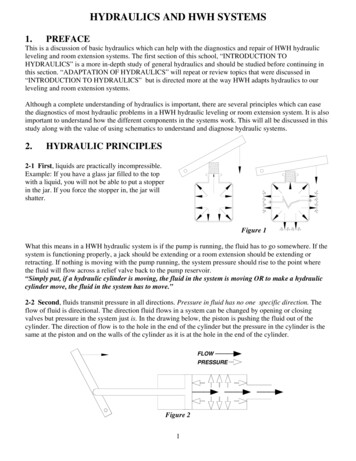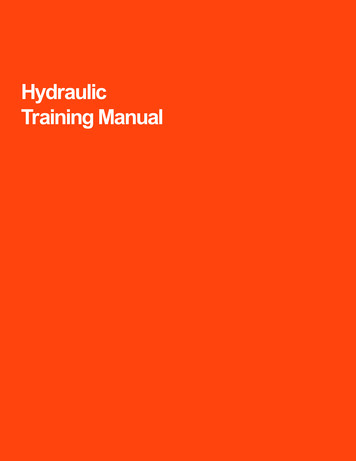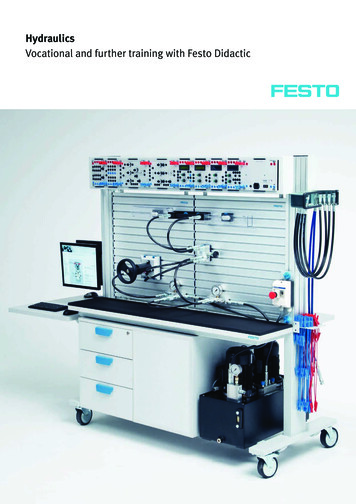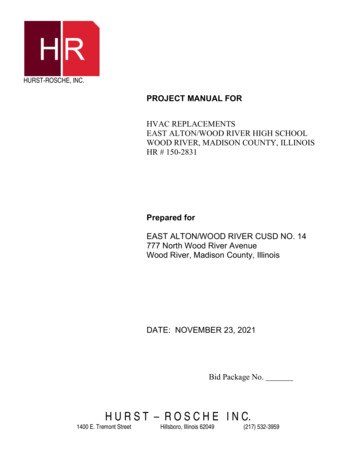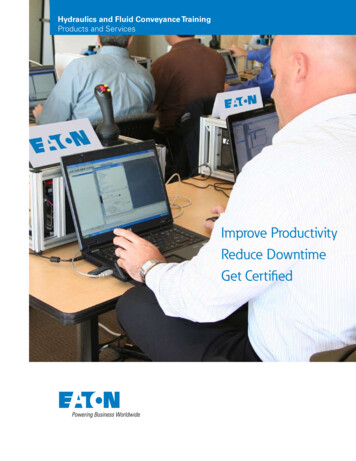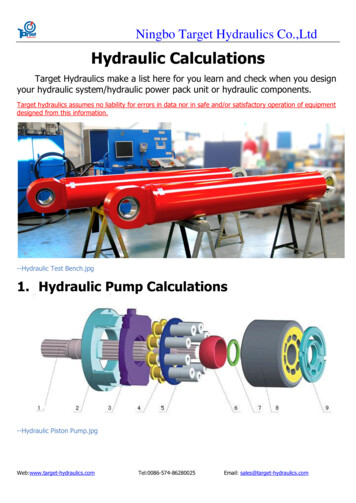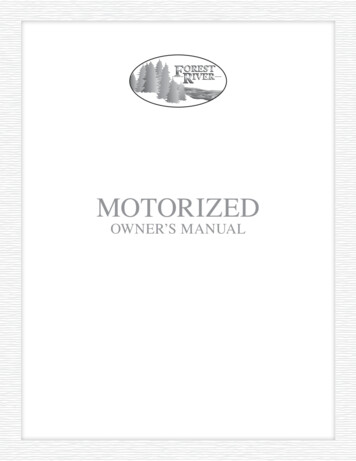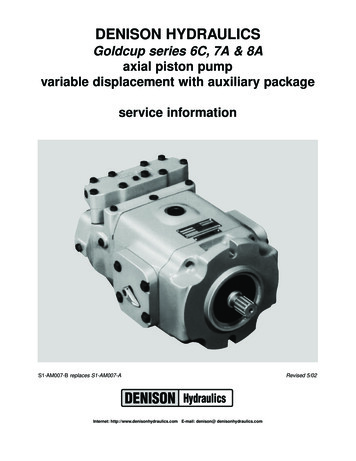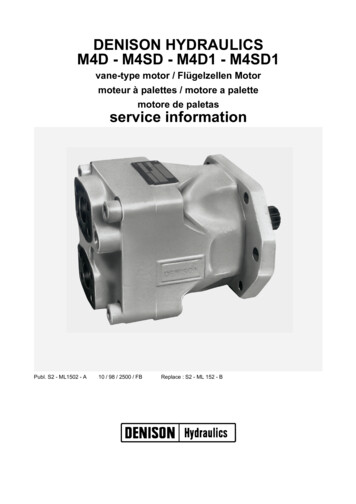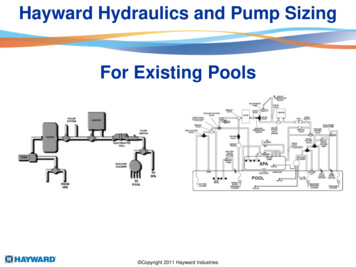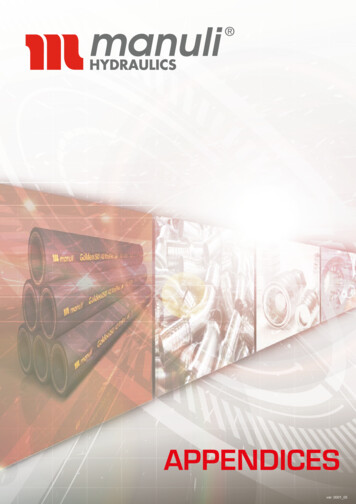
Transcription
River HydraulicsGEOLOGICALSURVEY WATER-SUPPLYThis water-supply paper was published asseparate chapters A-EPAPER1369
UNITED STATES DEPARTMENT OF THE INTERIORSTEWART L. UDALL, SecretaryGEOLOGICAL SURVEYThomas B. Nolan, Director
CONTENTS[The letters in parentheses designate separately published chapters]Page(A) Selected topics of fluid mechanics, by Carl E. Kindsvater(B) Energy losses associated with abrupt enlargements in pipes, withspecial reference to the influence of boundary roughness, by Carl E.Kindsvater(C) Surges in natural stream channels, by S. B. Rantz(D) Flow through openings in width constrictions, by Jacob Davidian,P. H. Carrigan, Jr., and John Shen(E) Stream gaging control structure for the Rio Grande conveyance channel near Bernardo, New Mexico, by D. D. Harris and E. V.RichardsonO1537791123
Selected TopicsOf Fluid MechanicsGEOLOGICALSURVEYWATER-SUPPLYPAPER1369-A
Selected TopicsOf Fluid MechanicsBy CARL E. KINDSVATERRIVERHYDRAULICSGEOLOGICAL SURVEYWATER-SUPPLYPAPER 1369-AA discussion of the concepts offluid mechanics which are thefoundations of river hydraulicsUNITED STATES GOVERNMENT PRINTING OFFICE, WASHINGTON : 1958
UNITED STATES DEPARTMENT OF THE INTERIORFRED A. SEATON, SecretaryGEOLOGICAL SURVEYThomas B. Nolan, DirectorFor sale by the Superintendent of Documents, U. S. Government Printing OfficeWashington 25, D. C. - Price 55 cents
CONTENTSPageAbstract- . - ------------ .Introduction.Technical symbols, terms, and basic conceptsLetter symbols and units - ------------ ------Boundary conditions.Fluid properties.Motion (flow) propertiesForce properties - - ------- -------Ratios and coefRcients - - - - ---Mathematical symbols - ------------ -------Basic concepts of mechanics - - - ------- - Basic concepts of fluid mechanicsEquations of motionFundamental equation of motionExternal forces in fluid motion.Kinematics of fluid motionEquations for a simple fluid motionHydrostatics.PiezometryOne-dimensional equation - - ----Equation of eontmuity - -- -- ---- ----- Discharge equation.Flow net.- -- --- ----- ---- ---- ------The experimental methodInfluence of shearExperiments and the theory of similitude.Influence of a free surface - -----RecapitulationExample.The energy equationReview of the Bernoulli equationGeneral energy equationThe momentum equationUniform and gradually varied flowCharacteristics of uniform flow -The Chezy equation -Alternate derivation of the Chezy equationGradually varied flow in open channelsILLUSTRATIONS[Plates follow p. 52]PLATE 1. Flow through a two-dimensional orifice, piezometers in pipesand open channels, and three-dimensional orifices.2. Typical two-dimensional flow nets, two-dimensional sluice gate,forces acting on a fluid mass, and uniform flow in pipes andopen 29323334373740424646474850
RIVER HYDRAULICSSELECTED TOPICS OF FLUID MECHANICSBy CARL E. KINDSVATER*ABSTRACTThe fundamental equations of fluid mechanics are specific expressions of theprinciples of motion which are ascribed to Isaac Newton. Thus, the equationswhich form the framework of applied fluid mechanics or hydraulics are, in addition to the equation of continuity, the Newtonian equations of energy andmomentum. These basic relationships are also the foundations of river hydraulics.The fundamental equations are developed in this report with sufficient rigorto support critical examinations of their applicability to most problems met byhydraulic engineers of the Water Resources Division of the United States Geological Survey. Physical concepts are emphasized, and mathematical proceduresare the simplest consistent with the specific requirements of the derivations.In lieu of numerical examples, analogies, and alternative procedures, this treatment stresses a brief methodical exposition of the essential principles.An important objective of this report is to prepare the user to read the literatureof the science. Thus, it begins with a basic vocabulary of technical symbols,terms, and concepts. Throughout, emphasis is placed on the language of modernfluid mechanics as it pertains to hydraulic engineering. The basic differentialand integral equations of simple fluid motion are derived, and these equations are,in turn, used to describe the essential characteristics of hydrostatics and piezometry. The one-dimensional equations of continuity and motion are definedand are used to derive the general discharge equation. The flow net is describedas a means of demonstrating significant characteristics of two-dimensional irrotational flow patterns. A typical flow net is examined in detail.The influence of fluid viscosity is described as an obstacle to the derivation ofgeneral, integral equations of motion. It is observed that the part played byviscosity is one which is usually dependent on experimental evaluation. Itfollows that the dimensionless ratios known as the Euler, Froude, Reynolds,Weber, and Cauchy numbers are defined as essential tools for interpreting andusing experimental data. The derivations of the energy and momentum equations are treated in detail. One-dimensional equations for steady nonuniformflow are developed, and the restrictions applicable to the equations are emphasized.Conditions of uniform and gradually varied flow are discussed, and the originof the Chezy equation is examined in relation to both the energy and the momentum equations. The inadequacy of all uniform-flow equations as a means ofdescribing gradually varied flow is explained. Thus, one of the definitive problemsof river hydraulics is analyzed in the light of present knowledge.Regents-Professor of Civil Engineering, Georgia Institute of Technology, Atlanta, Oa.; consultant to tbeU. S. Geological Surrey.1
2RIVER HYDRAULICSINTRODUCTIONThis report is the outgrowth of a series of short schools conductedduring the spring and summer of 1953 for engineers of the SurfaceWater Branch, Water Resources Division, U. S. Geological Survey.The topics considered are essentially the same as the topics selectedfor inclusion in the schools. However, in order that they might servebetter as a guide and outline for informal study, the arrangement ofthe writer's original lecture notes has been considerably altered.The purpose of the report, like the purpose of the schools whichinspired it, is to build a simple but strong framework of the fundamentals of fluid mechanics. It is believed that this framework iscapable of supporting a detailed analysis of most of the practicalproblems met by the engineers of the Geological Survey.It is hoped that the least, accomplishment of this work will be toinspire the reader with the confidence and desire to read more of therecent and current technical literature of modern fluid mechanics.TECHNICAL SYMBOLS, TERMS, AND BASIC CONCEPTSThe material in this section is the basic language of fluid mechanics.The reader is urged to become thoroughly acquainted with thesesymbols, terms, and fundamental concepts before reading the subsequent text.LETTER SYMBOLS AND UNITSBOUNDARY CONDITIONSA6, BDLnPRrsSArea; sq ft or ft2.Width of section; ft.Diameter of a circular section; ft.A length, as defined; ft.Direction or distance perpendicular to streamlines inthe s, n plane; as a radial distance it is measuredpositively toward the center of curvature; ft.Wetted perimeter or perimeter of the wetted crosssection; ft.Hydraulic radius; ratio of the area to the wettedperimeter; ft.Radius of a circular arc or radial distance; as adistance it is measured positively from the centerof curvature; ft.Direction or distance along or parallel to streamlines;ft.Hydraulic "slope"; in uniform-flow equations it isthe flow-distance gradient of either the total energyhead or the piezometric head.
SELECTED TOPICS OF FLUID MECHANICSVmyVolume; cu ft or ft3.Direction or distance perpendicular to streamlines inthe s, m plane and at right angles to the n direction;ft.A direction or distance; as a plane coordinate it isusually horizontal; ft.A direction or distance; as a plane coordinate it isusually vertical; in open channels it is the depth offlow referred to the average bottom level; ft.Elevation of a point referred to a horizontal datum;ft.FLUID PROPERTIES7 (gamma)P (rho)M (mu) r (sigma)e (epsilon)Specific or unit weight; weight per unit volume; Ibper cu ft or lb/ft3.Mass density; ma'ss per unit volume; also, ratio ofspecific weight to acceleration of gravity; slugs percu ft, slugs/ft3, or Ib-sec2/ft4.Viscosity; dynamic viscosity; lb-sec/ft2.Surface tension; lb/ft.Modulus of elasticity; psf or lb/ft2.MOTION (FLOW) PROPERTIESHQt,TvAcceleration; rate of change of velocity with respectto time; a vector quantity; ft/sec2.The acceleration due to gravitational force, usuallytaken to be essentially constant in magnitude(32.2) and fixed in direction (vertically downward);ft/sec2.Piezometric head; in general, equivalent to pressurehead plus elevation; for uniform flow in openchannels, it is equivalent to the elevation of thefree surface; ft.Total energy head; energy in ft-lb/lb of fluid flowing;ft.Volume rate of flow per unit width; discharge perfoot of width; cfs per ft or ft3/sec/ft.Volume rate of flow; total discharge at a cross section; cfs or ft3/secAn interval of time; sec.Velocity at a point; instantaneous time rate of displacement of a particle or point; a vector quantityas distinguished from speed, which is scalar; fpsor ft/sec.
4VRIVER HYDRAULICSAverage velocity in a cross section; ratio of total discharge to the normal area of a cross section; fps orft/sec.FORCE PROPERTIESFMpWT (tau)it (eta)Force; a vector quantity; Ib.Mass; ratio of weight to the acceleration due togravity; a scalar quantity; slugs.Pressure intensify; normal (pressure) force per unitarea; a scalar quantity; psf or lb/ft2.Weight; total force due to gravity; a vector quantity,always vertical; Ib.Shear stress; tangential (shear) force per unit area;psf or lb/ft2.Eddy viscosity; apparent viscosity due to turbulence; lb-sec/ft5.RATIOS AND COEFFICIENTSCCeCenCdCLCTKna (alpha)j8 (beta)EFAny coefficient; usually dimensionless.Coefficient of contraction; ratio of area of contractedstream to gross area of opening; dimensionless.Coefficient in the Chezy equation; has dimensions ofV#, units of ft /sec.Coefficient of discharge; dimensionless.Energy-loss coefficient; dimensionless.Shear-force coefficient; dimensionless.A constant.Coefficient in the Chezy-Manning equation; hasdimensions of RH, units of ft*.Velocity-head coefficient; ratio of the true averagevelocity head in a cross section to the velocityhead computed on the basis of the average velocityin the section; dimensionless.Momentum coefficient; ratio of true rate of transferof momentum (momentum flux) at a cross sectionto the momentum ,flux computed on the basis ofthe average velocity in the section; dimensionless.Euler number; ratio of a unit inertia! reaction to aunit pressure force; a basic flow parameter.Froude number; ratio of a unit inertial reaction to aunit weight force; a number which varies inverselywith the relative influence of weight on the flowpattern; dimensionless.
SELECTED TOPICS OF FLUID MECHANICSRWC5Reynolds number; ratio of a unit inertial reaction toa unit viscous shear force; a measure of the relativeinfluence of viscosity; dimensionless.Weber number; ratio of a unit inertial reaction to aunit surface-tension force; a measure of the relativeinfluence of surface tension; dimensionless.Cauchy number; ratio of a unit inertial reaction to aunit elastic force; a measure of the relative influence of elasticity; dimensionless.MATHEMATICAL SYMBOLSA (delta)S (sigma) ***H-»Change in value; final value minus initial value;increment.Summation.Proportional to ; varies as.Approximately equal.Vector addition.BASIC CONCEPTS OF MECHANICSNewton's laws of motion. Engineering mechanics, which includesthe mechanics of solid and rigid bodies as well as fluids, is based onNewton's hypotheses or "laws" concerning the behavior of massesacted upon by external forces. The fundamental proposition isstated in the second law of motion: a mass acted upon by an unbalanced external force or force system has an acceleration which isproportional to and in the direction of the resultant force. Thisproposition is expressed algebraically in the familiar relation 2F x.Ma,in which both F and a are recognized as vector quantities. In arectilinear coordinate system, for example, *2Fx x.Max, 2Fy x.Mav, andThe first law is: A mass remains at rest or moves with constantvelocity in a straight line until acted upon by an unbalanced resultantexternal force; or, in accordance with the second law, if S,F 0, thena 0. The first law, as applied to fluid mechanics, describes bothhydrostatic and uniform-flow conditions.The third law is: A mass acted upon by another mass exerts anequal, opposite, and simultaneous reaction. If "2F is defined as theresultant external force acting on a mass, then Ma is the inertialreaction of the mass.It is apparent that Newton's second law of motion provides aquantitative expression for the relationship between force, mass, andacceleration which is the basis for all equations of motion in engineering mechanics,
6RIVER HYDRAULICSDimensions. The dimension of a quantity is its classification according to a system of independent physical categories. BecauseNewton's second law is a complete description of a mass in motion,the fundamental dimensions are the dimensions of the quantities involved in a physical statement of the law. Thus, the fundamentaldimensions are mass, length, time, and force (M, L, T, and F) fromthe relationship F xMa xML/T2. Quantities such as acceleration,power and momentum are derived quantities; their dimensions areexpressed in terms of the fundamental dimensions. Because the 4fundamental dimensions are related by means of the Newtonian equation, an adequate dimensional system need involve only 3 dimensions. Commonly used dimensional systems involve F, It, and T, orM, L, and T.Units of measure. For each of the fundamental dimensions thereis an accepted unit of measure. Thus, L is measured in feet,, f inpounds, T in seconds, and M in slugs. Only three units nee be involved in a complete dimensional system, however. For example,slugs need not be used in the F, L, T system. The units of derivedquantities such as acceleration, power, and momentum are expressedonly in terms of the units of the fundamental dimensions,The American engineering system of units is an absolute system;that is, in the basic relationship Foc(ML/T2) K(ML/T*), the proportionality constant, K, is taken to be unity. Thus, a force of 1 poundproduces in a mass of 1 slug an acceleration of 1 foot per second persecond. It follows that, expressed in the absolute system of units,Newton's second law can be written 2F Ma.Kinematics. Kinematics deals with the description of motionwithout respect to the forces which cause or influence this motion,Kinematics involves only time and space.Dynamics. Dynamics deals with the effect of forces in causing orchanging the motion of a mass. It is further subdivided into staticsand kinetics.Statics. Motions described under this heading correspond to thecondition of zero acceleration in the directions considered.Kinetics. Kinetics is that branch of dynamics which deals with theaccelerated motion of a mass under the influence of unbalanced external forces.Work. Work is the product of a force and the distance over whichthe force acts in accomplishing motion. Work is a scalar quantity;it does not involve the time during which the force acts. Work ismeasured in foot-pounds (ft-lb).Power. Power is the time rate of doing work. The power delivered to a moving body is proportional to the product of the forceproducing the motion and the velocity of the body in the direction of
SELECTED TOPICS OF FLUID MECHANICS7the motion. Power is a scalar quantity. The unit of power is footpounds per second (ft-lb per sec) or horsepower. One horsepower isequivalent to 550 ft-lb per sec.Energy. A body upon which work is accomplished acquires therebythe capacity to do an equal amount of work. The capacity to dowork is called energy. Thus, energy is a measure of work, and viceversa. Energy is a scalar quantity. The unit of both work andenergy is the foot-pound (ft-lb).Momentum. Linear momentum is the product of mass and velocity.It is a vector quantity, and its unit is the pound-second (Ib-sec).Impulse. Linear impulse is the product of a force and the timeduring which the force acts. It is a vector quantity. From Newton's second law, impulse accomplishes and is equivalent to the changein momentum experienced by the mass acted upon. The unit of impulse is, therefore, the same as that of momentum, the pound-second(Ib-sec).BASIC CONCEPTS OF FLUID MECHANICSContinuity and discharge. Fluid mass can be neither created nodestroyed by virtue of its motion. Thus, in a steady fluid flow bertween solid boundaries or through a streamtube, the rate of passageof fluid mass through successive cross sections is constant. If thefluid be one of negligible compressibility (constant density), the rateof passage of fluid volume past successive sections is also constant.This is the simple basis for the continuity principle. The principleis expressed, for example, in the equation 2 .AV constant, whereQ is the volume rate of flow, or discharge, in cubic feet per second andV is the average velocity normal to the surface represented by thearea (A). In a section of nonuniform velocity, the total discharge isthe summation (or integral) of the discharges through the elementaryareas comprising the total area of the section.Uniform and steady motion. Velocity in a fluid motion is a vectorquantity and it is a function of both time and space. When thevelocity remains constant with respect to time, the flow is describedas steady. Most problems in engineering hydraulics involve steadymotion.When the velocity is constant with respect to distance in the direction of motion, the flow is described as uniform. Uniform flow occursin long pipes. It seldom occurs in natural open channels.Rotational and irrotational motion. The distinction between rotational and irrotational motion is essentially mathematical. The mostsignificant characteristics of an irrotational flow are those usuallyassociated with the classical "ideal" or "frictionless" fluid (a fluidwithout compressibility or viscosity). It is pertinent to the subse-
8RIVER HYDRAULICSquent use of the flow net in these notes to observe that irrotationalityis corequisite to the existence of a flow net.Laminar and turbulent motion. Laminar fluid motion is characterized by a steady, translatory movement of all particles (small elements)of the fluid. Turbulence imposed on a laminar flow is eventuallydamped out by the viscous shear forces. Because viscous forces arelarge relative to inertial reactions in laminar motion, this conditioncorresponds to low values of the Reynolds number.Turbulent motion is characterized by an erratic, small-scale eddyingmotion which is superposed on the translatory movement of the fluidmass. Local disturbances are rapidly dispersed throughout a turbulent fluid flow because the viscous shear forces are small relative tothe inertial reactions resulting from the turbulence. Thus, turbulentflow corresponds to high values of the Reynolds number. For mostpractical purposes, motion which is turbulent is described in terms ofthe 'average translatory velocity at a point or in a cross section.Critical, tranquil, and rapid motion. It the mean total energy headreferred to the bottom of an open channel is a minimum for a givendischarge, the flow is described as critical. When critical flow occursin a straight, rectangular, or nearly rectangular channel in which thevelocity in the cross section is essentially constant, the average velocityis theoretically equal to the velocity of a small gravity wave, and theFroude number is equal to unity. The flow is described as tranquil ifthe average velocity is less than the critical value. If the averagevelocity is greater than the critical value, the flow is described asrapid.Shear and pressure. The total force on any surface within a fluidin motion can be resolved into tangential and normal components.The tangential component of the total force on the surface is the shearforce (FT). The limit of the ratio of the shear force to the area of thesurface as the area approaches zero is the shear stress at a point (T).The normal component of the total force on an area is the pressureforce (Fp). The limit of the ratio of the pressure force to the areaas the area approaches zero is the pressure intensity (p) at a point.Pressure intensity is a scalar quantity.A fluid at rest with respect to its boundaries is in a state of zeroshear stress throughout. It follows that pressure changes imposedat one point in a fluid mass at rest are transmitted undiminished toall points in the fluid mass (Pascal's principle). Furthermore, becauseshear stresses cannot exist in a fluid at rest, the resultant force on anysurface within the fluid is a pressure force, and it is normal to thesurface.Viscous and turbulent shear. The viscous-shear force (FJ is a consequence of internal stresses which resist fluid deformation.
SELECTED TOPICS OP FLUID MECHANICS9relative movement of the fluid on adjacent stream surfaces in a laminarflow results in a viscous-shear stress (TM) . In a motion of this kind, TV isa function of the fluid viscosity and the velocity "gradient", a property of the flow defined as the rate of change of the tangential velocitywith respect to distance perpendicular to the motion. The viscousshear stress at any point in the flow pattern, therefore, is TM fj,(dvs/dn), where ju is the dynamic viscosity of the fluid and dvjdn is thevelocity gradient at the point. It is significant that TM is independentof fluid density and pressure.The total shear force (FT) acting on a fluid in turbulent motion isthe sum of the viscous shear (F and the turbulent shear (FJ. Turbulent shear is a consequence of the momentum exchange betweensmall masses of fluid moved transversely by the action of the turbulence eddies. Unlike viscous-shear stress, turbulent-shear stress (T,)is a function of fluid density, and it is independent of fluid viscosity.It can be shown that the turbulent-shear force acting on a fluidelement is directly proportional to its inertial reaction. It followsthat the Reynolds number is proportional to the ratio of turbulentshear to viscous shear, or R oc T,/TM. The influence of viscous shear isnegligible in fully developed turbulence.Boundary layer. The boundary layer was originally conceived as ameans of correlating real fluid motion with the theoretical behaviorof the hydrodynamicist's ideal fluid. Thus, Prandtl suggested thatin flows at high Reynolds numbers the effect of fluid viscosity couldbe assumed to be limited to a narrow region near the confining boundaries. This concept is of fundamental importance in the analysis offlow around bodies immersed in relatively large fluid spaces. It isalso essential to an understanding of certain phenomena associatedwith the establishment of uniform flow at entrances to conduits orfollowing local disturbances in an otherwise uniform conduit. Inregions of fully established flow, as in long pipes and open channels,the boundary layer is virtually the entire cross section of the flow.Streamlines and streamtubes. A streamline is a line drawn througha flow in such a manner that at every point along its length it is tangentto the velocity vector. It follows that there can be no flow across astreamline; in this sense, the streamline imposes a boundary conditionon the adjacent flow.A streamtube is a surface formed entirely of streamlines; in otherwords, it is the surface defined by the streamlines passing through aclosed curve. As the boundary of a streamtube is comprised ofstreamlines, there can be no velocity and, therefore, no flow throughthe walls of a streamtube. Any solid boundary or separation surfacewhich effectively guides the flow has the properties of a streamtubesurface.
10RIVER HYDRAULICSStagnation and separation. A stagnation point in fluid motion isdefined as a point of zero velocity. When boundary conditions causea flow to undergo an abrupt convergence, a tendency for stagnationoccurs at a point on the boundary. In a sharp, concave boundarycorner, or on the nose of a blunt obstruction, for example, the flowalong the boundary would apparently experience an instantaneouschange in direction of motion. As this implies an infinite normalacceleration if the tangential velocity were anything but zero, stagnation occurs.When flow boundaries diverge abruptly, as in sudden enlargementsor following blunt obstructions, the boundary ceases to guide theflow effectively and separation occurs. Thus, the apparent requirement that the fluid undergo an infinite acceleration at the boundarydiscontinuity does not, in this example, result in stagnation. Instead,the live stream separates from the boundary and follows a "freestream" surface bounded by eddying fluid. As a consequence ofviscosity, such eddy-filled separation zones also occur in corners nearregions of boundary convergence, thereby preventing stagnation.EQUATIONS OF MOTIONFUNDAMENTAL EQUATION OF MOTIONThe principal objective of fluid mechanics is a mathematicaldescription of fluid motion. Newton's second law is the basis forequations of fluid motion. The sense of Newton's proposition iscontained in the algebraic expression l 2FccMa KMa. This isa vector relationship which states that the resultant of all externalforces acting in a particular direction on a mass is proportional tothe product of the mass and its acceleration in the direction of theresultant force. If the quantities involved in this expression areevaluated in accordance with an absolute system of units, then K 1.0,or 'LF Ma. In the Cartesian space system, for example, 2Fx Max,and 2FgEXTERNAL FORCES IN FLUID MOTIONThe independent forces which influence fluid motion are the consequence of 1 property of state (pressure) and 4 physical propertiesof the fluid (density, viscosity, surface tension, and elasticity). Anadditional force, the apparent shear force due to fluid turbulence(-F7,), is not recognized as an independent force because it is directlyproportional to the inertial characteristics of the flow.Pressure, or pressure intensity, is a scalar quantity which describesi Except where emphasis Is Intended, the symbols and technical terms defined In the preceding sectionare used in the subsequent text without further explanation.
SELECTED TOPICS OF FLUID MECHANICS11a particular kind of fluid stress. Pressure is the cause of a resultantexternal force (Fp) only when it varies in the direction of motion.Density is involved in fluid motion in two distinctly different ways.Thus, density accounts for an accelerative force (Fg) which is thecomponent of the weight (W) in the direction considered. The definitive equation, W Mg pVg, is a particular form of Newton's secondlaw in which p is the density and g is described as the acceleration dueto gravity. On the other hand, the total inertial reaction due to theresultant of all the external forces, which might or might not includea component of the weight force, also involves the density; that is,Viscosity is a fluid property which accounts for a shear forcewhenever fluids are in motion with respect to their boundaries.Viscous shear is the result of molecular forces which oppose fluiddeformation. In turbulent fluid motion the total shear force (FT)is the sum of F? and the turbulent shear force (F,) .Surface tension is the name given to certain manifestations ofmolecular forces which occur at the interface between differentsubstances; for example, between a free jet of water and the surrounding air. The surface-tension force (Fa) is ordinarily of appreciablemagnitude only when the other forces involved are extremely andunusually small.Elasticity, or forces due to elastic deformation (Ft), are involvedprimarily in the unsteady flow of liquids and in the flow of gases underhigh pressure gradients. Neither of these problems is pertinent tothis discussion.KINEMATICS OF FLUID MOTIONA mathematical description of fluid motion necessarily involves thespace-time characteristics which are known as velocity and acceleration.Velocity is the time rate of displacement of a mass or a point. Forexample, if As is a small displacement or distance traversed along astreamline in a short time interval (M) , and if vs is the average tangential velocity in the interval on that part of the streamline, thenvs As/M. It follows that the instantaneous tangential velocity ata point on a streamline is vs dsjdt.Velocity is a vector quantity. Thus, the total or resultant velocityat a point is the vector sum of its components on the various vectoraxes. From the definition of a streamline, the total velocity in the"natural" or s, n, m system of coordinates is vt, and the normal components, vn and vm, are zero. For many purposes, however, theCartesian or x, y, z system of describing motion in three-dimensionalspace is preferred. Thus, in the Cartesian system v vx- *
12RIVER HYDRAULICSVV V j where -f- indicates vector addition and vx dx/dt,vv dy/dt, and vt dz/dt.Acceleration is time rate of change of velocity. As this discussionis concerned with steady motion only, the variation of the velocityat a point, with respect to time, is always zero. Thus, in the generaldefinition a dv/dt, the change in velocity represented by dv is thechange which occurs over the distance travers
of river hydraulics is analyzed in the light of present knowledge. Regents-Professor of Civil Engineering, Georgia Institute of Technology, Atlanta, Oa.; consultant to tbe U. S. Geological Surrey. 1. 2 RIVER HYDRAULICS INTRODUCTION This repor
